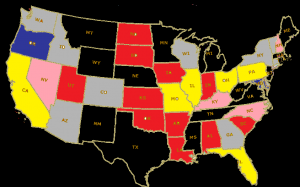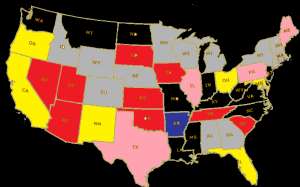2010 Election Predictions – How we rank individual races (revised criteria)
Our calls on individual races are based on a composite of polls conducted over the last 28 days (we will compress this “lookback period” once primary season has concluded) using the following criteria:
(1) Safe Democratic (dark blue on the map)/Safe Republican (dark red on the map) – either a candidate leads by 10 or more points, or a candidate has over 50% in polls;
(2) Lean Democratic (light blue on the map)/Lean Republican (light red on the map) – a candidate leads by 3-9 points;
(3) Tossup (yellow) – a candidate leads by less than 3 points;
(4) No data available/primary has not been held (gray) – Up until now, we have refrained from analyzing individual races until both parties’ nominees were selected for competitive primaries. However, we’ve noticed that several pollsters have been releasing multiple polls with different Democratic/Republican matchups for states that have not held their primaries. Since we want to paint a complete and accurate picture of the 2010 races, we therefore are slightly modifying our rule as to which polls we will analyze: starting with this analysis, if at least one of the major parties has a clear front runner in a contested primary, we will use the various poll matchups to get a sense of how a Senate/Governor race is leaning and, based on that composite of polls in the last 28 days, will assess which party is ahead.
(5) No Senate/gubernatorial race in 2010 for this state (black);
2010 Election Predictions – Senate Races
(7/14 projection: 55 Democrats, 45 Republicans, or Republican gain of +4)
(7/1 projection: 54 Democrats, 46 Republicans, or Republican gain of +5)
(6/22 projection: 55 Democrats, 45 Republicans, or Republican gain of +4)
Since our last analysis, the Senate race in Pennsylvania has tightened into “too close to call” territory, which is understandable given the fact that Pennsylvania has always been a competitive state. However, we have similarly noticed that the California Senate race (featuring three term incumbent Barbara Boxer) has recently slipped from “leans Democratic” to “tossup” as well.
While the June 28 death of longtime Senator Robert Byrd (D-West Virginia) would seem to create another open seat race/pickup opportunity for the Republicans, the Democratic governor (who has considerable bipartisan popularity) is strongly considering running for the seat this fall; until then, he will appoint a caretaker to keep the seat in Democratic hands until the end of the year. All that remains is for the Democratic legislature to go into special session to clarify the election law to provide for a special election to be held in November. The only unknown about this race is whether the state’s lone Republican (Shelley Moore Capito) would give up her safe House seat to run for the Senate.
2010 Election Predictions – Governor’s Races
(7/14 projection: 31 Republicans, 19 Democrats, or Republican gain of +7)
(7/1 and 6/22 projections: 29 Republicans, 21 Democrats, or Republican gain of +5)
Though the Oregon Governor’s race has moved from “Leans Republican” to “Tossup” (the Republican lead has shrunk down to 44-43%), we are for the first time including poll results from Kansas, Oklahoma, and Tennessee that are rated as “Safe Republican” and, in this case, are all projected GOP pickups. Furthermore, we have been receiving recent poll results from Maryland showing a tossup race in that Democratic state – the Republican governor who was defeated for re-election in the Democratic wave of 2006 is seeking a comeback, and currently is tied with the incumbent at 45-45%.
Battle for Congress and Governor – House Races
(7/14 projection: 261 Republicans and 174 Democrats, or Republican gain of +82, with 14 Democrats on the “watch list”)
(7/1 projection: 260 Republicans and 175 Democrats, or Republican gain of +81, with 6 Democrats on the “watch list”)
(6/22 projection: 260 Republicans and 175 Democrats, or Republican gain of +81, with 5 Democrats on the “watch list”)
Two recent events have caused us to revise our estimate of Republican gains: (1) the ranks of “Congressman behaving badly” (explained here) has expanded by one, as Ciro Rodriguez (D-Texas) was caught on camera losing his cool in front of a constituent who accused him of not telling the truth about the costs of healthcare reform – though he already was on our watch list due to weak poll numbers, we are now promoting him to this special group of vulnerable Democrats; (2) we had explained in a prior posting that nine incumbent Democrats we had previously thought were safe voted against the party’s budget. We speculated that this “no” vote was due to internal warning signs they were getting that not all was well in their district, thus causing them to “vote their district” to save their political hides. Therefore, we are adding these Democrats to our “watch list”: Bobby Bright (D-Alabama), Rob Filner (D-California), Jim Marshall (D-Georgia), Walt Minnick (D-Idaho), Dan Lipinski (D-Illinois), Mike Michaud (D-Maine), Gene Taylor (D-Mississippi), Ike Skelton (D-Missouri), and John Adler (D-New Jersey).
2010 Election Predictions – Generic Congressional Vote
(7/1 poll composite: 45.1% Republican, 42.7% Democrat – +2.4% Republican)
(7/1 poll composite: 44.1% Republican, 42.2% Democrat – +1.9% Republican)
(6/22 poll composite: 44% Republican, 42.2% Democrat – +1.8% Republican)
Recent polling has detected a noticeable trend towards those who plan to vote for a Republican for Congress this fall. It’s also worth noting that these polls are typically taken both of chronic and occasional voters and thus understate the more energized Republican vote; a recent poll conducted only of likely voters showed a 56-41% GOP preference for Congressional elections. To put this number in perspective, when the GOP recaptured both houses of Congress in 1994 for the first time since 1994, the GOP/Democratic vote for House candidates was 52-45%. If this 56% number were the actual GOP House vote on Election Day, we could easily see GOP gains in the 80 seat range, as our projections have suggested or some time.
In the next installment of this article (we are waiting for Congressional filing to close in New York at the close of business today), we will discuss upcoming primaries in August and September.
John is a political consultant and blogger with JMC Enterprises with expertise in poll sample development and analysis, development of targeted voter files for phone canvassing or mail outs, campaign strategy and demographic consulting, among other things. See his site at WinWithJMC.com for more information.
Advertisement
Advertisement


